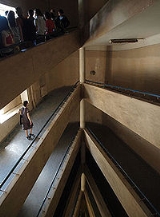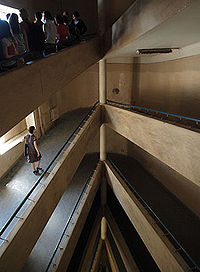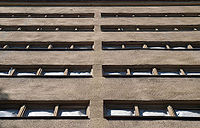
Communal House of the Textile Institute
Encyclopedia

Constructivist architecture
Constructivist architecture was a form of modern architecture that flourished in the Soviet Union in the 1920s and early 1930s. It combined advanced technology and engineering with an avowedly Communist social purpose. Although it was divided into several competing factions, the movement produced...
landmark located in the Donskoy District
Donskoy District
Donskoy District is an administrative district of Southern Administrative Okrug, and one of the 125 raions of Moscow, Russia....
of Moscow
Moscow
Moscow is the capital, the most populous city, and the most populous federal subject of Russia. The city is a major political, economic, cultural, scientific, religious, financial, educational, and transportation centre of Russia and the continent...
, Russia
Russia
Russia or , officially known as both Russia and the Russian Federation , is a country in northern Eurasia. It is a federal semi-presidential republic, comprising 83 federal subjects...
. The building, designed by Ivan Nikolaev
Ivan Nikolaev
Ivan Sergeevich Nikolaev was a Soviet architect and educator, notable for his late 1920s constructivist architecture and later work in industrial architecture....
to accommodate 2000 students, was erected in 1929-1931 and functioned as a student dormitory until 1996. As of August 2008, parts of the building are leased as office space, while the main residential block is abandoned and gutted inside; the current owner, Moscow Institute of Steel and Alloys
Moscow Institute of Steel and Alloys
National University of Science and Technology "MISIS" is Russia's primary technological university in the field of steelmaking and metallurgy. It was established in 1918 as a part of the Moscow Mining Academy. In 1930, it became independent...
, plans to rehabilitate the dilapidated structure into a modern campus.
Design
The Communal House of the Moscow Institute of Steel and Alloys became the first solo project for 28 year old Ivan Nikolaev of the OSA GroupOSA Group
The OSA Group was an architectural association in the Soviet Union, which was active from 1925 to 1930 and considered the first group of constructivist architects...
; the contract awarded to him was a part of a larger project that included three student campus
Campus
A campus is traditionally the land on which a college or university and related institutional buildings are situated. Usually a campus includes libraries, lecture halls, residence halls and park-like settings...
es in (then) remote areas of Moscow. The contract specification defined a modest maximum construction cost and building volume (50 cubic meters) per student. Any communal facilities, from staircases to libraries, counted towards the quota and decreased the actual living space. While all architects addressed these constraints by reducing available living space, Nikolaev's proposal was the most radical of all.
Nikolaev's principal design rule was a strict physical separation of common study space, public services (with cafeteria, showers and storage rooms) and the living space. Thus the building was H-shaped: a public services block connected a 200-meter long, 8-story dormitory with a 3-story study block. Since all the students' possessions - from textbooks to day clothing - had to be stored in the lockers of the public services block, Nikolaev reduced dormitory rooms to sleeping space only. Initially, a standard sleeping cabin for two had a very small area, 2×2 meters, but 3.2 meters tall. It had no windows and was connected by the door to a long corridors running along the exterior wall. Nikolaev attempted to compensate for the shortage of space with elaborate ventilation
Ventilation (architecture)
Ventilating is the process of "changing" or replacing air in any space to provide high indoor air quality...
system. This proposal seemed too radical even for the Soviet avant-garde
Russian avant-garde
The Russian avant-garde is an umbrella term used to define the large, influential wave of modern art that flourished in Russia approximately 1890 to 1930 - although some place its beginning as early as 1850 and its end as late as 1960...
, and the cabins were increased to 2,7×2,3 meters with proper windows.

Steel frame
Steel frame usually refers to a building technique with a "skeleton frame" of vertical steel columns and horizontal -beams, constructed in a rectangular grid to support the floors, roof and walls of a building which are all attached to the frame...
structure. Initially Nikolaev designed all load-bearing in steel, but due to metal rationing
Rationing
Rationing is the controlled distribution of scarce resources, goods, or services. Rationing controls the size of the ration, one's allotted portion of the resources being distributed on a particular day or at a particular time.- In economics :...
he eventually replaced internal floor supports with wooden girder
Girder
A girder is a support beam used in construction. Girders often have an I-beam cross section for strength, but may also have a box shape, Z shape or other forms. Girder is the term used to denote the main horizontal support of a structure which supports smaller beams...
s. The building had elevator
Elevator
An elevator is a type of vertical transport equipment that efficiently moves people or goods between floors of a building, vessel or other structures...
s, but they were reserved for cargo deliveries only. Instead, the students had to use three spacious staircases - two in the living block and one in the public services building. The latter had an unusual triangular shape, with smooth ramps instead of stairs, as in contemporaneous work
Tsentrosoyuz building
The Tsentrosoyuz Building or Centrosoyuz Building is a government structure in Moscow, Russia, constructed in 1933 by Le Corbusier and Nikolai Kolli. Centrosoyuz refers to a Soviet bureaucracy, the Central Union of Consumer Cooperatives. The building included office space for 3,500 personnel, as...
by Le Corbusier
Le Corbusier
Charles-Édouard Jeanneret, better known as Le Corbusier , was a Swiss-born French architect, designer, urbanist, writer and painter, famous for being one of the pioneers of what now is called modern architecture. He was born in Switzerland and became a French citizen in 1930...
. These staircases are sometimes compared to the spiral ramp of the Guggenheim Museum
Solomon R. Guggenheim Museum
The Solomon R. Guggenheim Museum is a well-known museum located on the Upper East Side of Manhattan in New York City, United States. It is the permanent home to a renowned collection of Impressionist, Post-Impressionist, early Modern, and contemporary art and also features special exhibitions...
in New York City
New York City
New York is the most populous city in the United States and the center of the New York Metropolitan Area, one of the most populous metropolitan areas in the world. New York exerts a significant impact upon global commerce, finance, media, art, fashion, research, technology, education, and...
.
According to Nikolaev, the lives of the students should have been regulated in a nearly military communal fashion. After a common wake-up call all the students proceeded to common physical exercise areas (either a gym in winter or an open area in summer); at this moment the residential block was to be locked until late evening. After exercise, the students took a shower and dressed up in the public service locker rooms; after a breakfast in the canteen they followed their college schedule - either in off-site auditoriums or in the study block facilities. Nikolaev suggested injecting ozone
Ozone
Ozone , or trioxygen, is a triatomic molecule, consisting of three oxygen atoms. It is an allotrope of oxygen that is much less stable than the diatomic allotrope...
into ventilation ducts at night and even considered sedating
Sedative
A sedative or tranquilizer is a substance that induces sedation by reducing irritability or excitement....
students to ensure they all fall asleep in due time . Except for centralized sedation, this paramilitary order was actually maintained in the first years of operation, but later the regulations were eased up.
Decay and rehabilitation
In 1941 the Textile Institute faculty was evacuated in deep rear, and its classes dissolved; the vacant campus was used by the military. After World War II the campus was taken over by the Moscow Institute of Steel and AlloysMoscow Institute of Steel and Alloys
National University of Science and Technology "MISIS" is Russia's primary technological university in the field of steelmaking and metallurgy. It was established in 1918 as a part of the Moscow Mining Academy. In 1930, it became independent...
; students that returned in 1945 found the building heavily infested by bedbugs. Although contemporary architects regard the initial construction quality of the building as quite good for its period, by the 1960s it was falling apart. In 1968 it was renovated by Yakov Belopolsky under Nikolaev's supervision. The project took care of real-world student needs but was constrained by the existing structure and costs. For example, common toilet rooms located in the extemities of a 200-meter long building were expanded with shower rooms. However, there were still only two such rooms on each floor, and the students living in the center of the building still had to run a hundred meters there and another hundred back. The living cubicles were marginally enlarged at the expense of corridors and acquired larger windows; the ventilation system was, on the contrary, downgraded to less demanding standards.
In the next three decades the building fell into disrepair again. It lost the canopy over main entrance in 1980s and the wraparound balconies in 2006 were torn down for safety reasons. The living block was shut down in 1996; all wooden ceilings and partitions inside it were eventually torn down, exposing the steel frame inside an empty concrete shell. The campus nominally still belongs to the Institute of Steel, but the space of the former study and public services blocks is leased piecemeal to unrelated organizations. Architectural professionals and the general public were and are well aware of the poor state of the landmark, partly because it is located near the Moscow Architectural Institute dormitory and so became a regular subject of academic studies.
A new rehabilitation plan, supervised by Vladimir Kulish of Moscow Architectural Institute, was approved in 2007 with an estimated cost of 600 million roubles (25 million US dollars). According to this plan, the rooms will be enlarged to at least 11 (single student) or 17 (double) square meters, with individual showers and toilets. The study block will be renovated back to the original plans and functions. As of March 2008, the rehabilitation is being financed through a specially appropriated federal budget fund.

